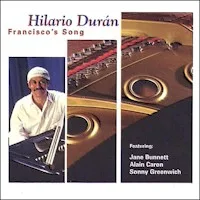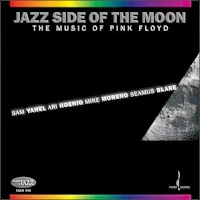Styles: Brazilian Jazz, Bossa Nova
Year: 1986
File: MP3@320K/s
Time: 52:04
Size: 119,6 MB
Art: Front + Back
(3:04) 1. O Barquinho
(3:55) 2. Garota De Ipanema
(3:34) 3. Berimbau
(3:14) 4. Desafinado
(3:18) 5. Wave
(2:48) 6. Corcovado
(3:09) 7. Águas De Março
(3:35) 8. A Felicidade
(4:00) 9. Manhã De Carnaval
(3:45) 10. Chega De Saudade
(2:58) 11. Meditação
(2:34) 12. Samba De Uma Nota Só
(4:00) 13. Água De Beber
(1:49) 14. Você E Eu
(2:25) 15. Samba Do Avião
(3:47) 16. O Que Será
Year: 1986
File: MP3@320K/s
Time: 52:04
Size: 119,6 MB
Art: Front + Back
(3:04) 1. O Barquinho
(3:55) 2. Garota De Ipanema
(3:34) 3. Berimbau
(3:14) 4. Desafinado
(3:18) 5. Wave
(2:48) 6. Corcovado
(3:09) 7. Águas De Março
(3:35) 8. A Felicidade
(4:00) 9. Manhã De Carnaval
(3:45) 10. Chega De Saudade
(2:58) 11. Meditação
(2:34) 12. Samba De Uma Nota Só
(4:00) 13. Água De Beber
(1:49) 14. Você E Eu
(2:25) 15. Samba Do Avião
(3:47) 16. O Que Será
Nara Leão, the Musa da Bossa Nova (Bossa Nova's Muse, as she is affectionately known), was a prominent figure in bossa nova. She didn't restrict herself as a bossa nova singer, though, and was one of the first artists to engage in the movement later known as "canção de protesto" (protest song), an artistic movement which denounced military dictatorship in Brazil. She launched the careers of such composers/interpreters as Chico Buarque, Zé Keti, Martinho da Vila, Edu Lobo, Paulinho da Viola, and Fagner. An international performer in spite of her short, uneducated voice, she left an expressive discography even though death caught her by surprise at such a precocious age.
When she was a year old, she and her family left Vitória for Rio. In 1954, she took her first violão classes with Solon Ayala and Patrício Teixeira, and then with Roberto Menescal and Carlos Lyra. As an amateur, she participated in the first university presentations where bossa nova was coming together as an organized movement. She performed with names such as João Gilberto, Luiz Eça, Ronaldo Bôscoli (with whom she would have a love affair and later become his fiancée), Carlos Lyra, and others. At that time, she was a reporter for Rio's newspaper Última Hora. The ample apartment of her complacent parents in Rio's south side (zona sul), Copacabana, Posto 4, became a meeting point for musicians, which led many to erroneously establish it as a bossa nova cradle (actually, the cradle was, to some extent, the Cantina do César, but even more appropriately, the Plaza nightclub around 1952). In 1963, she debuted as a professional, working in the musical comedy Pobre Menina Rica, by Vinícius de Moraes and Carlos Lyra. While working on the play, they also acted at the Carioca nightclub Au bon Gourmet. She also debuted in that year in recording studios, singing "Naná" (Moacir Santos), which was included in the movie soundtrack to Ganga Zumba, Rei dos Palmares (Cacá Diegues). She also recorded two tracks on Carlos Lyra's LP Depois do Carnaval (Philips): the marcha-rancho "Marcha da Quarta-Feira de Cinzas" (Carlos Lyra/Vinícius de Moraes) and the samba-jazz "Promessas de Você" (Carlos Lyra/Nelson Lins e Barros). Also in 1963, she toured Brazil, Japan, and France with Sérgio Mendes. When they toured the Northeast, Leão was introduced by Roberto Santana to the so-called Vila Velha Gang, the baianos Caetano Veloso, Gilberto Gil, Gal Costa, and Maria Bethânia. Her first LP (Nara), recorded by Elenco, launched the sambista do morro (sambista of the hill) Zé Keti into the middle-class circle with great success with his song "Diz que Fui por Aí" (with H. Rocha).
When she was a year old, she and her family left Vitória for Rio. In 1954, she took her first violão classes with Solon Ayala and Patrício Teixeira, and then with Roberto Menescal and Carlos Lyra. As an amateur, she participated in the first university presentations where bossa nova was coming together as an organized movement. She performed with names such as João Gilberto, Luiz Eça, Ronaldo Bôscoli (with whom she would have a love affair and later become his fiancée), Carlos Lyra, and others. At that time, she was a reporter for Rio's newspaper Última Hora. The ample apartment of her complacent parents in Rio's south side (zona sul), Copacabana, Posto 4, became a meeting point for musicians, which led many to erroneously establish it as a bossa nova cradle (actually, the cradle was, to some extent, the Cantina do César, but even more appropriately, the Plaza nightclub around 1952). In 1963, she debuted as a professional, working in the musical comedy Pobre Menina Rica, by Vinícius de Moraes and Carlos Lyra. While working on the play, they also acted at the Carioca nightclub Au bon Gourmet. She also debuted in that year in recording studios, singing "Naná" (Moacir Santos), which was included in the movie soundtrack to Ganga Zumba, Rei dos Palmares (Cacá Diegues). She also recorded two tracks on Carlos Lyra's LP Depois do Carnaval (Philips): the marcha-rancho "Marcha da Quarta-Feira de Cinzas" (Carlos Lyra/Vinícius de Moraes) and the samba-jazz "Promessas de Você" (Carlos Lyra/Nelson Lins e Barros). Also in 1963, she toured Brazil, Japan, and France with Sérgio Mendes. When they toured the Northeast, Leão was introduced by Roberto Santana to the so-called Vila Velha Gang, the baianos Caetano Veloso, Gilberto Gil, Gal Costa, and Maria Bethânia. Her first LP (Nara), recorded by Elenco, launched the sambista do morro (sambista of the hill) Zé Keti into the middle-class circle with great success with his song "Diz que Fui por Aí" (with H. Rocha).
She also reintroduced to the same circle the older sambista do morro Cartola ("O Sol Nascerá," together with Elton Medeiros). Along with these two songs, which became all-time hits, another two songs recorded on that album had the same success: "Consolação" (Baden Powell/Vinícius de Moraes) and "O Morro" (Carlos Lyra/Gianfrancesco Guarnieri). On that album, she evidenced her social concerns (still a bit naïve), choosing a non-bossa repertoire. These concerns were even more evident in the following phase of her career when a coup took power over Brazil and installed the military dictatorship; this event provoked her to actively denounce it. Her second album, Opinião de Nara (Leão's opinion, Philips, 1964), brought "Opinião" (Zé Keti). In December 1964, she made a great success with the show Opinião (Gianfrancesco Guarnieri/Augusto Boal) at the Teatro Opinião (Rio). The show brought together Leão, a middle-class young girl, Zé Keti, representing the morro people, and João do Vale, from the poor region of Northeast.
The show was such a longtime success that it robbed the middle-class audiences making the important samba redoubt Zicartola profitable, which was owned by Cartola himself; it closed its doors soon afterwards. It also killed bossa nova in Brazil. Leão delivered passionate speeches against bossa nova in that time, calling it an "alienating" movement. At the same time, the instrumental backing of the show Opinião was pure bossa, as can be heard on a CD reissued in 1994, informing that the rupture, at that time, was more ideological than musical. In 1965, she presented Chico Buarque with his songs "Pedro Pedreiro" (strong social thematic) and "Olê, Olá." Also in that year, she participated in the Teatro Opinião show Liberdade, Liberdade (freedom, freedom), by Flávio Rangel/Millôr Fernandes. She also appeared on Elis Regina/Jair Rodrigues' regular TV show O Fino da Bossa, which eventually also had Chico Buarque, Gilberto Gil, Caetano Veloso, Edu Lobo, Tom Jobim, Vinícius de Moraes, and Ivan Lins. In 1966, she recorded her album Manhã de Liberdade (Philips). Defending Chico Buarque's "A Banda," together with him at TV Record's II FMPB (1966, São Paulo), she won first place (together with "Disparada," by Geraldo Vandré and Théo de Barros). Leão recorded "A Banda," together with the first song composed by the duo Gilberto Gil/Capinam, "Ladainha." The next year, she sang, together with its author, "A Estrada e o Violeiro" (Sidney Miller), at the III FMPB. The song was awarded for Best Lyrics. Between 1966 and 1967, she and Chico Buarque had a regular weekly TV show (Pra Ver a Banda Passar, TV Record). In 1966, she was almost framed in the National Security Law by the War department due to a direct critique against the military in an interview with the Carioca newspaper Diário de Notícias ("our military forces are of no avail").
The show was such a longtime success that it robbed the middle-class audiences making the important samba redoubt Zicartola profitable, which was owned by Cartola himself; it closed its doors soon afterwards. It also killed bossa nova in Brazil. Leão delivered passionate speeches against bossa nova in that time, calling it an "alienating" movement. At the same time, the instrumental backing of the show Opinião was pure bossa, as can be heard on a CD reissued in 1994, informing that the rupture, at that time, was more ideological than musical. In 1965, she presented Chico Buarque with his songs "Pedro Pedreiro" (strong social thematic) and "Olê, Olá." Also in that year, she participated in the Teatro Opinião show Liberdade, Liberdade (freedom, freedom), by Flávio Rangel/Millôr Fernandes. She also appeared on Elis Regina/Jair Rodrigues' regular TV show O Fino da Bossa, which eventually also had Chico Buarque, Gilberto Gil, Caetano Veloso, Edu Lobo, Tom Jobim, Vinícius de Moraes, and Ivan Lins. In 1966, she recorded her album Manhã de Liberdade (Philips). Defending Chico Buarque's "A Banda," together with him at TV Record's II FMPB (1966, São Paulo), she won first place (together with "Disparada," by Geraldo Vandré and Théo de Barros). Leão recorded "A Banda," together with the first song composed by the duo Gilberto Gil/Capinam, "Ladainha." The next year, she sang, together with its author, "A Estrada e o Violeiro" (Sidney Miller), at the III FMPB. The song was awarded for Best Lyrics. Between 1966 and 1967, she and Chico Buarque had a regular weekly TV show (Pra Ver a Banda Passar, TV Record). In 1966, she was almost framed in the National Security Law by the War department due to a direct critique against the military in an interview with the Carioca newspaper Diário de Notícias ("our military forces are of no avail").
In 1967, she recorded the LP Canto Livre de Nara. In 1968, she joined the Tropicalista movement, joining Caetano Veloso, Gilberto Gil, Rogério Duprat, Tom Zé, Capinam, Os Mutantes, Torquato Neto, and Gal Costa on the LP Tropicália ou Panis et Cirsensis. The same year, she recorded her LP Nara Leão, on which she sang Ernesto Nazareth's "Odeon" that had Vinícius de Moraes' lyrics written especially for her. The LP, released at the Carioca nightclub Le Bilboquet, brought two of Veloso's compositions, ("Mamãe Coragem" and "Deus vos Salve Esta Casa Santa," both with Torquato Neto) and the arrangements of Rogério Duprat, which helped establish a connection with Tropicalia.
She had decided to stay out of television for a whole year, for not agreeing with the short vision of art of the producers. In the next year, she moved to France and recorded another LP. In 1971, she recorded Dez Anos Depois (Polydor) in Paris and then went back to Brazil. In the next year, she appeared in the film Quando o Carnaval Chegar (by Cacá Diegues, her husband), together with Chico Buarque and Maria Bethânia. In the following years, she began her psychology college studies, leaving music aside. In that period, she made only sporadic appearances on shows and albums from other artists, such as Fagner. In the late '70s, she released her LP Meus Amigos são um Barato (Philips, 1977), with appearances by Tom Jobim, Carlos Lyra, Edu Lobo, Chico Buarque, Caetano Veloso, Gilberto Gil, Roberto Menescal, and others. As she learned she had cancer, she returned with full impetus to her career, recording another 11 LPs until 1988. In 1997, she was the theme of the first play by renowned moviemaker Júlio Brassane, Vida-Névoa-Nada. ~ Alvaro Neder http://www.allmusic.com/artist/nara-le%C3%A3o-mn0000371530/biography
Garota de Ipanema




















